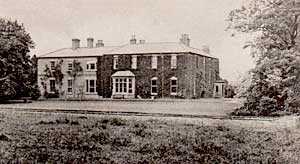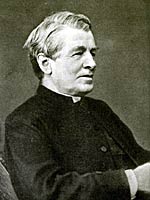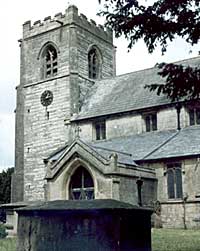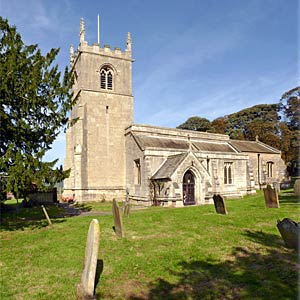< Previous | Contents | Next >
The Man Who Loved the Rose
CAUNTON. Here among the little hills, just off the lovely road from Newark to Ollerton, Caunton's red houses and small grey church are gathered pleasantly about the willow-bordered Beck. It is the village of the man Tennyson called the Rose King.

Caunton Manor, c.1910.
Hiding in splendid trees near the church is Caunton Manor, a pleasant old brick house with a stone portico, where the Holes have lived since the 15th century. Here Samuel Reynolds Hole lived for the greater part of his life (though born at Manchester), first as curate, then as vicar and squire, before serving as Dean of Rochester. Here he loved and studied roses, grew them, wrote of them, promoted societies for their cultivation and shows for their exhibition, and made himself the most famous of amateur rose-growers. We found roses blooming in his old garden when we called.

Dean Hole.
In a quiet corner of the grounds is a summerhouse where we found his portrait, an illuminated address congratulating him on becoming Dean of Rochester, a diploma awarded him in 1897, and, most interesting of all, an alphabetical list in his own handwriting of all the roses he was growing here in 1851, when he had 1027 trees and over 400 varieties. Since 1904 he has been sleeping in the churchyard, a granite cross marking his grave.
By the churchyard gate is a peace memorial of unusual interest, for the stones of its grey walling, fashioned like a monument, were once part of the 13th century church. On it we read:
These men of Caunton sought the glory of England. They found the glory of God.

Caunton church, 1984.
There is still much of 700 years ago in the little church, which is lighted by windows from the three medieval centuries and a 15th century clerestory. The chancel arch, the font, and the nave arcades are all 13th century, the south arcade a little older than the north. A fine elm grows near the 14th century porch which shelters an elaborate doorway of the same time. The tower and its arch are 15th century. There are three old piscinas, a founder's recess, an ancient bracket carved with a curly head, and quaint corbels on the hoods of the windows.
In memory of the Dean the chancel is neatly panelled in oak, and the beautiful glass in the west window shines red, blue, green, and gold, having portraits of Elizabeth of Hungary with roses and lilies, St Andrew with a book and a cross, St Dorothy with a spray of roses, and an angel with golden wings holding a scroll with the words, "The desert shall rejoice and blossom as the rose."
Dean Hole gave the poor glass of the east window and three chancel lancets in memory of his parents, two sisters, and "a beloved friend John Leech," the famous Punch artist. The witty dean would help him with many of his drawings, and he enjoyed the strange distinction for a clergyman of being elected to Mr Punch's table.
There are many tablets and some attractive windows (one with St George), to the Bristowes who fought for Parliament in the Civil War, and have lived since the 16th century at Beesthorpe Hall a mile away. From the road to Maplebeck we see their big Elizabethan house, grey and gabled, in a wooded park laid out by Capability Brown. Another Elizabethan structure is embodied in a farmhouse known as Dean Hall, standing back from the Newark road.
Brave Parson Hodge

Clarborough church in 2014.
© Copyright Alan Murray-Rust and licensed for reuse under this Creative Commons Licence.
CLARBOROUGH. It has three things to see, a church and a yew and a glorious view of the countryside to Sherwood Forest.
Some say the yew is older than the church, and may have been growing a thousand years; it is still green and shapely, though its great days are gone and only half its hollow trunk is left. The much-restored church has a 15th century tower of two stages with a sundial on a buttress. From about 1400 come fine windows in the chancel and the very narrow aisles, the massive font with quatrefoils, and the south arcade. The 13th century north arcade is the oldest part. The only coloured glass glows richly in the east window, showing John the Baptist in raiment of camel hair, crying out as he sees Our Lord on the edge of a crowd.
A brass tells in quaint rhyme the virtues of George Mower, a boy of 14 who died in 1752; one of the Mowers gave the church an ancient silver chalice. A monument with a draped woman bowed over an urn has a long inscription to the Outybridge family.
Here there preached last century Parson Hodge, who proved himself a hero one terrible night. He was on board the Royal Charter when, after a voyage from Australia, she was wrecked off Anglesey in 1859. While a sailor tried to swim ashore with a rope, brave Parson Hodge calmed 500 terrified passengers by holding a prayer meeting. Before help reached them the ship was shattered on the rocks, and when morning broke only 39 people were left to tell the story of how Clarborough's parson spent his last moments.
Below the floor of a cottage on the lane to Welham is the once renowned well which gave that village its name. A flight of steps goes down to the water in a stone basin 12 feet square.
